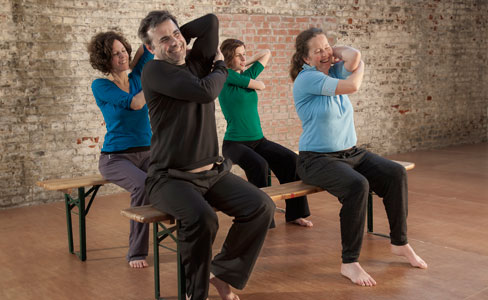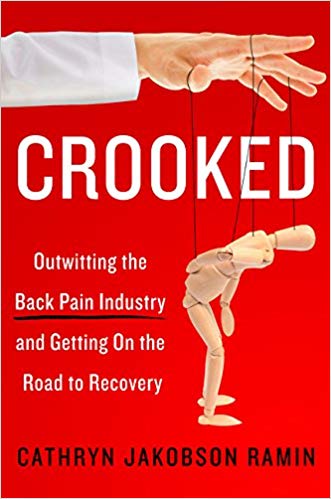
Investigative reporter Cathryn Jakobson Ramin is the author of “Crooked: Outwitting the Back Pain Industry and Getting on the Road to Recovery.” From her first-hand experience as a back-pain sufferer, and from extensive research, interviews, and site visits, her book brings new public awareness to the prevalence of dangerous and ineffective treatments, devices, and pharmaceuticals offered to desperate people in search of solutions.
In the second half of her book, she details her personal experience with outside-the-medical-system solutions, and which ones were effective. She became enthusiastic about the Feldenkrais Method of somatic education and its potential to put people on the “road to recovery.” She continues to practice the Feldenkrais Method, and recommends it widely.
We caught up with Cathryn recently in the midst of a busy travel schedule to talk about her continuing interest in the back pain industry, and the Feldenkrais Method.
SA: We would love to know what you see has changed, or not, about the back pain industry In North America, since you wrote your book in 2017.
CJR: Hmm. well, that is a very good question. And I think it depends on who I’m talking to.
So what has changed actually? It has become much more difficult for physicians to just send people off for MRIs and have insurance pay for it.
It’s become more difficult to give a diagnosis of “degenerative disc disease” and have that be the only reason for surgery. Insurance companies have become much more skeptical about [prescribing] lots and lots of epidural steroid injections. They have certainly become entirely skeptical about prescriptions for opioids.
So all of these things have changed, but unfortunately what has not changed enough yet is a way to pay or help people pay for the types of interventions that actually do lead to recovery. And which guidelines have clearly shown are the correct approach: that being exercise and cognitive behavioral therapy.
I speak with a number of insurers, with self-insured organizations and with workers compensation providers, and they’re all interested in figuring out how to allow this for their patients in some cases. They’re willing to sponsor the use of an app. And that’s good, but it’s not going to be enough, and I spent a lot of time conveying the idea that most people who have been in chronic pain are dealing with so many emotional factors on top of their physical factors and perhaps also underneath the physical factors, that they are really not going to be able to work this one out by themselves. In most cases they are going to need a “Back Whisperer,” which is what I talk about in my book and that’s can be any kind, that can be any number of people. I mean, I personally have served as a Back Whisperer for a few friends and relatives. I don’t have any qualifications whatsoever. But I believe enough in a certain amount of movement, and convincing your brain that you are actually okay and not in any risk of dying because you’re doing these exercises. And that really can help! And I’ve just seen lots and lots of people who are certain that what they should do is get in bed, actually instead get on the floor. And actually they’re moving they’re not just lying there.

It’s going to be a long time before we can arrange payment as a way of getting getting people to actually use these interventions and we’re always going to be dealing with people who can’t afford to take advantage of this, but they can have surgery. And I have certainly seen that the surgical community now that the diagnosis and the codes for degenerative disc disease are not flying so much with the insurers move on to other things like instability.
“Instability” is a more accessible way to describe spondylolisthesis. That sort of sounds very technical, but you can just say the patient is unstable and everyone panics and approves the surgery. They’re also moving to do more decompression surgeries that then result in instability. So that’s handy. [sarcasm] But I also hear from more and more Physicians who were really saying “We’re not going to do it anymore. It doesn’t work, we’re not doing it, and we are going to need to find other ways. “
So I’ve sent countless people to Feldenkrais. I mean it is my “go – to,” absolutely if I have a situation where someone is perhaps older, is not strong, has not been active. I also recommend people who are younger, but feel unable to cope with a stringent, serious, you know, intensive exercise routine. Yeah, I do think that they eventually need that routine. But it is a matter of gaining confidence that you can move and you will not die. And that is what Feldenkrais does: to actually tell your brain that you are in no imminent danger and things will improve.
SA: Let’s go back to the day that you walked into a Feldenkrais Awareness Through Movement® class for the first time. Can you tell us a little bit about what you what you experienced or what you thought about it? How did the class affect you?
CJR: I found a very welcoming feeling. I attended classes in San Francisco at the Feldenkrais Center for Movement Education, and in New York City at the Feldenkrais Institute. I sensed in both settings that we’re all in this together. A sense that you can see people around you who were not able to move and who are now moving. You see very old people who are able to move very well. In New York, I saw some of the most graceful people I’ve ever seen in my life. Just so beautiful in their movements that I couldn’t help but watch them. Now, they’re probably all dancers and that’s why they were so beautiful.
But just seeing that was so encouraging to me. Seeing a sea of people on the floor in New York, and all of us are doing the same kind of thing.
There’s no sense of criticism. There’s no sense that anybody is Doing It Wrong. There’s no sense that anybody’s going to come and move any part of you; and it’s very safe for people who don’t like to be touched. People who feel self-conscious about their athleticism. They don’t have to worry.
SA: Were you self-conscious or worried?
CJR: Not really.
I mean, I’m very used to being physically manipulated for various different interventions. I don’t worry about my athleticism either, but that you can’t do it wrong — that was really nice. That was nice because I’m not terribly cognitive. My brain is not too well connected to my body, you know, so if someone is saying, “You must do it exactly this way, and here are the steps, and now we’re going to do them,” very likely I’m not going to be able to do that. For instance. I love Tai Chi: but I cannot follow any sequence of movements. My brain just does not work that way.
In the Feldenkrais classes, there were so many people from every walk of life. We’re in there and that was just so cool because it’s very accessible financially for people and I appreciate that greatly.
We’re now almost in 2020, and the book came out in 2017. So this is a very long process. I have received emails every week from people who are in desperate shape, and they can’t afford these interventions that cost, you know, a hundred dollars an hour, whatever. They simply can’t do it. So I often am able to help them find Feldenkrais in their community. Not everywhere — certainly far from it, but I am often able to help them find it at a YMCA or JCC, or at a local hospital, and that really pays off for them.

SA: Cathryn, what was it about about your first experience in a class where you sort of knew for yourself, “Oh, I’m on the right track here?” Did that happen right away, or did it take a few classes?
CJR: It really happened right away because I knew that I started the class with very limited movement, and I was finishing the class with much more movement. I know that I started out being very uncomfortable. When I first went to a Feldenkrais class in San Francisco, I was still very much in the throes of back pain.
And so it was very noticeable to me that I now had much more latitude in my movements. I left the class feeling very relaxed and very happy, but not tired and certainly not sweaty. And that was one thing I thought was very nice — is that people could come in and put down their mats in there, whatever else, and do this in their street clothes, and they can get up and go out to dinner, and and it wasn’t a production.
I can persuade people to do that more easily — people who have a real “allergy” to the idea of sweating in a gym. They would do a Feldenkrais class.

SA: And did you also have the hands-on private Functional Integration® lessons?
CJR: Yes. I’ve had private Functional Integration lessons, both from Deborah [Bowes] in San Francisco, and from Marek [Wyszynski] in New York. In both cases, I found those to be helpful, but I probably didn’t do enough of it. I find the classes to be much more right for me.
I worry — I have had recently an experience where a friend of my mother-in-law’s came to me in dire straits. She’s a woman in her mid-80s, serious osteoporosis, terrible pain, told that she needed to have a spinal fusion. Lives alone. I felt very scared for her about having a spinal fusion, and I thought that fear was justified. She had been told she needed to take a whole lot of osteoporosis drugs by injection to prepare. It seemed very sketchy, so I called my friend Marek
Marek and I have done a lot of work together professionally at this point and I said, what do we do? And he said well, I’m going to be in touch with her and I’m going to take care of her. He really went out of his way.
What we really learned, was that the woman truly wanted to find out that she needed surgery. She wanted to try everything, and then decide to have surgery: so she tried everything and she decided to have surgery. I know she’s alive. I don’t know what her outcome is this point.
The point is, with some people, they’re not going to NOT have surgery. What concerns me about the Hands-On work is, there people who are going to love the Hands-On work, but they won’t want to do any other work. They won’t want to do the classes. They won’t want to move their bodies. They would like someone else to do it for them. And that is not a successful strategy.
So we know I imagine that all Feldenkrais practitioners are very aware of that, and do not encourage you come in, and they “work on you” and then you leave and do nothing else – because that is not a successful strategy.
SA: What words of encouragement would you give to a person who’s considering trying Feldenkrais classes to resolve their back pain?
CJR: I have given those words of wisdom out so many times! I have encouraged people to go ahead and take the risk. Some people say, “My doctor told me it’s it’s really not that safe for me to exercise,” and like well, believe me. This exercise is safe, you know, you are going to be perfectly safe. There are people much worse off than you in that room. You are going to be fine. I would say absolutely go and do it and risk it and see if you love it. Because if you do, you’re gonna knock down another huge obstacle in recovery, because in no time at all, you’re going to have a social life in your Feldenkrais class. And that is so keenly important. I think that is a big reason that Feldenkrais succeeds, because people meet each other in class. You’re intimate with each other in a way. By the time it’s over you’ve all been doing absolutely absurd things together, you know?
People develop relationships in class. When I first walked in to a Feldenkrais class in New York. I felt like I was walking into a really friendly place where I was embraced immediately. I did not feel like an outsider, and I think that that’s typical of these classes. That’s why I encourage people, especially people who spend way too much time isolated, or are uncomfortable with other people, go break the ice in there, you know, you will not break anything else while you’re at it.
SA: Do you still go to Feldenkrais classes?
CJR: Yes! I’m on my way to New York tomorrow, and I’m going to be at the institute for classes a lot while I’m there!
Learn more about Cathryn Jakobson Ramin on her website.
The Feldenkrais Guild of North America is an Amazon affiliate. Affiliate links appear in this article. When you click on the link to purchase a product, FGNA may receive a portion of your transaction.

